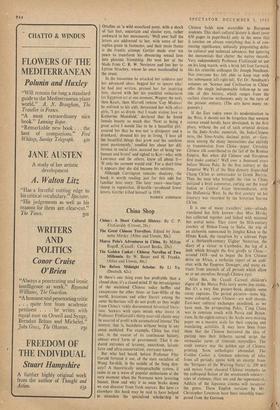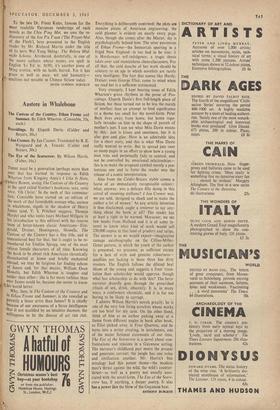China Shop
The Great Chinese Travellers. Edited by Jean- Rugoff. (Cassell: Caravel Books, 25s.)
IF there's one thing even less profitable than a closed shop, it's a closed mind. If the intransigence of the mainland Chinese today baffles and exasperates the other three- or four-fifths of the world, historians' and other literati among the outer barbarians still do not profit as they might from China's richly documented historical litera- ture. Seekers with open minds who invest in Professor FitzGerald's thirty-year-old classic may be assured of profit with accumulated interest. The interest, that is, backdates without being in any sense outdated. For example, China has tried out, in the course of its continuous history, almost every form of government. That it en- dured extremes of tyranny, anarchism, laissez- faire and ultra-conservatism, everyone knows.
But who had beard, before Professor Fitz- Gerald ferreted it out, of the state socialism of Wang An-shih, in the middle of the Sung dyn- asty? A theoretically unimpeachable system, it came in on a wave of popular enthusiasm at the very moment when the Normans were investing Sussex. How and why it so soon broke down we can discover from fresh sources. But here as elsewhere this book may be said to have helped to stimulate the specialised scholarship in Chinese fields now accessible to European students. This short cultural history is short (over 650 pages in paperback) only in the sense that it touches on almost everything that is of con- tinuing significance, unfussily pinpointing defin- ite cultural and technical advances, but ignoring the inessentials that clutter the native records. Very independently Professor FitzGerald set out on his long march, with a brisk left foot forward, like his scientific colleague Dr. Joseph Needham. Not everyone has felt able to keep step with the subsequent left-right-left. Yet Dr. Needham's volumes on 'Science and Civilisation in China' offer the single indispensable follow-up to one side of this history, which ranges from the earliest riverine settlements only to the turn of the present century. (The arts have many ex- ponents.)
If the East today owes its modernisation to the West, it should not be forgotten that western 'science could hardly have developed, in the first place, without the aid of such oriental devices as the lndo-Arabic numerals, the Indo-Chinese zero, the Sino-Arabic decimal point, or—fore- most among the many innovations due entirely to transmission from China—paper. Certainly Chinese silk contributed to the fall of the Roman Empire. But when did Chinese and European first make contact? Well over a thousand years before Marco Polo. In the first century ac the Emperor Wu Ti of the Han dynasty dispatched Chang Ch'ien as ambassador to Greek Bactria. Thus the man who brought the vine to China initiated a brief commerce, cutting out the usual Indian or Central Asian intermediaries, with the Hellenistic West. In the first century AD his itinerary was recorded by the historian Ssu-ma Ch'ien.
It is one of many travellers' tales—already translated but little known—that Miss Mirsky has collected together and linked with minimal but useful notes. They cover the fifth-century journey of Hsilan-Tsang to Itidia, the trip of an alchemist summoned by Jenghiz Khan to the Hindu Kush, the reception by a tolerant Pope of a thirteenth-century Uighur Nestorian, the diary of a visitor to Cambodia, the log of a junk which brought the first giraffe to China— around 1418—and so began the first Chinese drive on Africa, a verbatim report of an audi- ence with the Empress Dowager, and many ex- tracts from journals of all periods which allow us to see ourselves through Chinese eyes.
After this, the Cassell Caravel children's digest of the Marco Polo story seems less exotic. But it's a Very fine picture-book, despite some corny captions. The period pictures—some big, some coloured, some Chinese—are well chosen. East-west cultural exchanges antedked, as we have seen, the prospecting Polos. T'ang China was in constant touch with Persia and Byzan- tium. In the eighth century the Arabs were making paper on a massive scale for their copying and translating activities. It may have been from them that the Chinese borrowed the idea of putting into their hitherto sacred script the vernacular yarns of itinerant storytellers. The tenth century was the golden age of Chinese
printing. Soon anthologies abounded. The Golden Casket, a German selection of tales from all periods, opens with an excerpt from the `Intrigues of the Warring States' (c. 200 nc)
and moves from classical Chinese examples to the colloquial fiction of the seventeenth century: tales of violence, illicit sex and the supernatural. Addicts of the Japanese cinema will recognise the genre. These English versions by Mr. Christopher Levenson have been smoothly trans- posed from the German.
To the late Dr. Franz Kuhn, famous for the most readable European renderings of such novels as the Chin Ping Mei, we owe the re- discovery of the Jou P'u T'uan (`The Prayer-Mat of the Flesh'), here presented to the English reader by Mr. Richard Martin under the title of its hero Wei Yang ShOng: The Before Mid- night Scholar. Attributed. doubtfully, to one of the many authors whose names are spelt in English 'Li Yu' (c. 1650), it's another piece of Ming erotica, with no holds barred. Yet it has grace as well as pace, wit and humanity— qualities not notable in Chinese fiction today.
HUGH GORDON PORTEUS







































 Previous page
Previous page